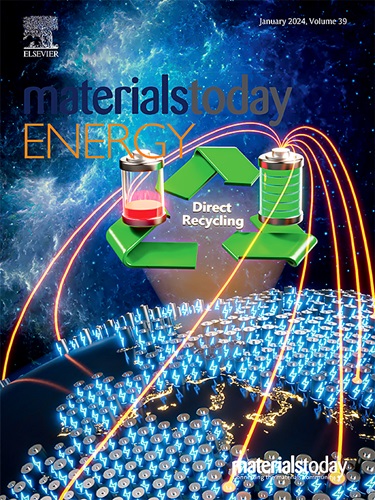Interface engineering of the dz2 electrons mobility for single atom catalytic activity and selectivity
IF 8.6
2区 材料科学
Q1 CHEMISTRY, PHYSICAL
引用次数: 0
Abstract
Transition metal singlet embedded in nitrogen-doped carbon material (M-N-C) has been demonstrated as a promising electrochemical oxygen reduction reaction (ORR) catalyst; however, the unsatisfying activity and production selectivity have hampered its widespread applications in energy storage and conversion technologies. Herein, interface engineering by facilitating M-N-C catalysts (M from 3d to 4d electron-containing elements) with MXene has been utilized to regulate their ORR performance. It is found that the charge transfer occurring within the interface not only tunes the electron occupancy of the 3d/4d orbitals of the metal site, but also delocalizes the population of the d states. This alternation enhances the mobility of the electrons and promotes the 4e catalytic process thermodynamically. Meanwhile, the formation of ∗HOOH, the key reaction intermediate for 2e reaction, is hindered due to the alleviation of the binding capacity, which is beneficial to improve production selectivity. This study provides foundational understanding for the ORR catalytic mechanism at the atomic level and opens up new avenues for designing high-demanded electrocatalysts.针对单原子催化活性和选择性的 dz2 电子迁移率界面工程设计
嵌入掺氮碳材料(M-N-C)中的过渡金属单质已被证明是一种前景广阔的电化学氧还原反应(ORR)催化剂;然而,由于活性和生产选择性不尽人意,阻碍了其在能源储存和转换技术中的广泛应用。在此,通过促进 M-N-C 催化剂(M 从 3d 到 4d 含电子元素)与 MXene 的界面工程来调节其 ORR 性能。研究发现,在界面内发生的电荷转移不仅调整了金属位点 3d/4d 轨道的电子占有率,而且还使 d 态的电子群失调。这种交替增强了电子的流动性,并在热力学上促进了 4e 催化过程。同时,由于结合能力的减弱,2e 反应的关键反应中间体 ∗HOOH 的形成受到阻碍,有利于提高生产选择性。这项研究为从原子水平理解 ORR 催化机理提供了基础,为设计高要求的电催化剂开辟了新的途径。
本文章由计算机程序翻译,如有差异,请以英文原文为准。
求助全文
约1分钟内获得全文
求助全文
来源期刊

Materials Today Energy
Materials Science-Materials Science (miscellaneous)
CiteScore
15.10
自引率
7.50%
发文量
291
审稿时长
15 days
期刊介绍:
Materials Today Energy is a multi-disciplinary, rapid-publication journal focused on all aspects of materials for energy.
Materials Today Energy provides a forum for the discussion of high quality research that is helping define the inclusive, growing field of energy materials.
Part of the Materials Today family, Materials Today Energy offers authors rigorous peer review, rapid decisions, and high visibility. The editors welcome comprehensive articles, short communications and reviews on both theoretical and experimental work in relation to energy harvesting, conversion, storage and distribution, on topics including but not limited to:
-Solar energy conversion
-Hydrogen generation
-Photocatalysis
-Thermoelectric materials and devices
-Materials for nuclear energy applications
-Materials for Energy Storage
-Environment protection
-Sustainable and green materials
 求助内容:
求助内容: 应助结果提醒方式:
应助结果提醒方式:


